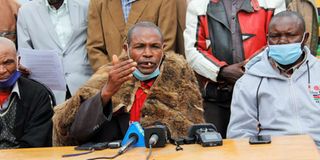Why it’s crucial to protect, develop community land

The Ogiek community has called on the government to give them a communal title deed for Mau Forest land.
What you need to know:
- The biggest chunk of unregistered land is in the 24 counties with community land.
- The provision for community land in the Constitution is a significant game changer.
On October 30, a historic event was convened in Laikipia County. For the first time, the Ministry of Lands issued title deeds under the Community Land Act 2016, and two pastoralist communities, Ilingwesi and Musul, benefited.
As an important pillar for productivity, there is a need for transparency in the ownership of land. Clarity has to be provided on who decides and benefits from land use. This must be done within a legal framework that provides for sustainability and inclusivity.
Inefficiencies in land transactions can hamper development, investments and conflict resolution. Title deeds are critical for security of ownership, inheritance and collateral for loans, notably for youth and women who currently own less than 10 per cent of registered land in Kenya.
The biggest chunk of unregistered land is in the 24 counties with community land. Most of these are in Arid and Semi-Arid Lands (Asals). Before the promulgation of the 2010 Constitution, there was no legal framework for the recognition and protection of the land rights of these communities.
Critical decisions
The provision for community land in the Constitution is a significant game changer. The 2016 Act gives effect to Article 63 of the Constitution.
The Act places the administration and management of land in the hands of communities as it recognises, protects and provides for their registration. Critical decisions on the allocation of portions of land to individuals must be approved by two-thirds of the community assembly. The law has set this high threshold to ensure that agriculture and pastoralist activities are sustained.
Participation of women and youth
Article 40 of the Constitution safeguards non-ancestral communities. The definition of the word ‘community’ goes beyond the narrow confines of ethnicity. The establishment of the Community Land Management Committees (CLMC) gives a clear legal framework for regulating the governance of land. In particular, women and youth have an opportunity to participate in land management.
Bank loans
Communities will have a stronger security of tenure, and can eventually use their title deeds as collateral for bank loans for investments to improve their livelihood, or for legal protection in case of partnership with investors.
County governments are required to deposit proceeds from investments in unregistered community land to profit-making accounts, pending registration. Once registration is completed, these monies must be transferred to the rightful beneficiaries.
This historic feat is a result of the collaboration and partnership between the Ministry of Lands and Physical Planning, the National Land Commission, the Council of Governors and the Food and Agriculture Organisation (FAO) of the United Nations, through the European Union-funded Land Governance Programme.
Globally, under land governance, the EU funds 18 country-level projects in Africa, Asia and Latin America, all of which address tenure issues, and are implemented alongside various partners, including government agencies, civil society organisations, bilateral and multilateral organisations and private contractors.
Through the land governance programme, the EU is working with the ministry and the NLC to enhance efficiency, transparency and accountability in land administration and management.
The expected outputs of this partnership include the digitisation of land records and processes, strengthening of land dispute resolution mechanisms, improvement of access to land-based information and inclusion of marginalised communities in land governance and natural resource management, as well as ascertainment of community land rights and active participation in sustainable physical and land use planning.
Improving Land Governance calls for the concerted efforts of the Government of Kenya, both at national and county level, the communities, civil society organisations and for the support of development partners.
The Judiciary, especially the Land and Environment Court, needs to be strengthened to reduce the backlog of cases. It is important to note that 70 per cent of the cases in the formal judicial system are related to land and natural resources, with more than 17,000 cases pending in the Environment and Land Court.
Dispute resolution mechanisms
Dispute resolution mechanisms can be bureaucratic. Vulnerable groups, including women and youth, are still the biggest victims of marginalisation.
Verification and Digitisation of land records and processes will restore the confidence of investors in the land sector. The Ministry should accelerate the development of the National Land Information System to allow for online land transactions.
The realisation of this significant milestone should re-ignite our collective desire to ensure that all communities are registered.
We want to go beyond the nine counties that are under the Land Governance Programme - Tana River, West Pokot, Turkana, Baringo, Marsabit, Samburu, Nandi, Laikipia and Vihiga - to reach the rest of the country as well. We are committed to life-changing partnership.




